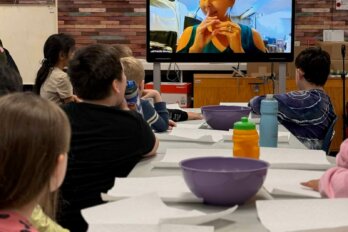Y WE TRAVEL
Why do we travel? For too long, we took this question for granted. Travel can make our large world small, and we forgot what a gift this is until it all got taken away from us not too long ago. Today, we’re returning to the skies in record numbers, but with a more appreciative mindset. It’s a perfect moment to take stock. The contributors to the “Y WE TRAVEL” series are accomplished writers from all walks of life. Over the length of this series, they will explore the diversity of purpose in our journeys—not just where or how, but why. On behalf of Toronto Pearson Airport and the Canadian Airports Council, please enjoy.
What do we mean by the word “nature?” I first left my home province of Quebec in search of answers to that question in 2013. That’s when my now-husband and I travelled to Indonesia, one of the world’s “17 ‘megadiverse’ countries,” craving radically different biomes.
While bouncing around the volcanic island chain, geckos crawled the walls of our hotels, surrounded by lush jungle. We saw bioluminescent plankton light up a shoreline, got dozens of minor stings from jellyfish after spotting sea turtles while scuba diving, and had our water bottle stolen by a long-tailed macaque in the Ubud Monkey Forest, which is home to banyan, teak, and over a hundred other tree species. A few days later, another forest macaque waited for scraps of our lunch as we trekked up the Mount Rinjani volcano.
“We are not the main characters on the world’s stage, but just one member of a gigantic chorus.”
But you don’t have to travel halfway around the world to engage with the wondrous creatures and plants that live alongside us. Nature can be found in surprising places—indeed, nearly everywhere. In 2020, French researchers Frédéric Ducarme and Denis Couvet dissected the history and limitations of the word “nature” in the famous journal of the same name. They highlight how it has always been an abstract concept, impossible to delineate.
Where We Travel

“Many Canadians think of Fort McMurray International Airport (YMM) as a gateway to the oil sands. Although a large percentage of passengers travel for work, many don’t realize that Fort McMurray Wood Buffalo boasts a culturally diversified population, bustling with young, energetic families looking to travel and enjoy their hard-earned money. I used to go south, chasing the sun, but after I joined the aviation industry, I suddenly found myself with new reasons and intrigue to travel overseas. Since 2019, I’ve travelled to Italy, France, Spain, Greece, Slovenia, Croatia, and Montenegro. When YMM won four airport service quality awards in 2023, I attended the awards ceremony in Seoul and tacked on some “bleisure” time. It was never on my bucket list to peer across the DMZ into North Korea, but I’m so glad I did. My travel bug has passed on to my stepson, who graduated from Keyano College here in town, launched an engineering career, and now flies out to places like Colombia in his time off. I take great pride knowing that so many exciting trips and journeys start with our airport and that YMM is able to be part of the many wonderful memories our passengers are making. It’s not just a critical economic driver, but our community’s gateway to the world.”
– Denean RobinsonPresident and CEO, Fort McMurray International Airport
That finding is relevant to travel, too. Nature is more than mountains and beaches. Nature is sandwiched between high-rises, lining alleyways, and surrounding parking lots. I’ve seen dolphins jumping from the waters of Istanbul’s Bosphorus Strait, been woken up by squawking peacocks in the suburbs of Miami, and caught sight of a furtive fox on Mont-Royal, Montreal’s famous overlook.
Nature truly is everywhere, even a place as densely populated as Mexico City. With a population of 21.6 million, it is the fifth-largest city in the world. Yet the megalopolis is also home to a rare salamander, the axolotl. This maned aquatic creature, whose permanently smiling face is now on Mexico’s 50-peso bill, lives in the murky waters of Xochimilco, an urban region in the city’s south with wetlands and a canal system that winds between chinampas (farming plots). Mexico is on the same biodiversity list as Indonesia.
Despite the busy streets of popular neighbourhoods like Roma and the Condesa, it’s not hard to see why. During my most recent trip to Mexico City, the sidewalks were lined with vine-snaked palms, while jacaranda trees shed fragrant blooms, dusting the sidewalks purple. It’s the sort of place where the greenery feels only half-heartedly contained. The wild resists, pushing through concrete cracks and reaching toward the sun.
It’s reassuring to see how nature needs no human intervention to thrive, but its strength does not mean permanence. The axolotls were native to the lakes surrounding Mexico City, which have been mostly drained to avoid flooding. Numbers have plummeted since the 1990s due to changed habitats, pollution, and invasive species. The rare amphibians are now mostly confined to the canals of these former lakes: the surviving limbs of largely disappeared bodies of water.
The fate of the axolotl is in the hands of the people fighting to defend it. They breed it in the tanks I saw during a stop on a trajinera boat tour. The tailed amphibians are raised step by step by these careful stewards until they are ready to be released back into the urbanized wild.
Indonesia’s long-tailed macaques are also threatened by deforestation and the illegal animal trade, while Mediterranean dolphins have declined due to marine pollution and overfishing. Even Montreal’s red fox has all but disappeared, spurring projects to build ecological corridors criss-crossing the city in support of its return. Urban nature is just as threatened as any other kind—often more so.
Travelling like this, with an eye trained on all non-human living things, allows novelty to become background. There is privilege in southern Florida’s pelicans going from rarity to common sighting during a vacation, an active part of the scenery that shifts shapes rather than staying static like a photograph. Many say they travel to immerse themselves in other peoples’ cultures; this immersion signals that our experience of the world is not central to a grand universal narrative. And if we travel to immerse ourselves in flora and fauna, we make the crucial realization that although humans have bent ecosystems to our will, we are not their focal points. We are not the main characters on the world’s stage, but just one member of a gigantic chorus.
According to soundscape ecologist Bernie Krause, if everyone could “shut the hell up, and listen,” they would hear something. When we slow down and take the time to stop acting on our surroundings, when we get still enough to realize that living continues without our participation, then we can see that its existence is just as meaningful as ours. Feeling that first-hand is different than knowing it cognitively, and that in situ experience can generate a magical sensation of awe. This contemplative human emotion can not only do wonders for calming our nervous system and releasing that free-loving hormone oxytocin, but it can also make us realize just how much there is that’s worth fighting to conserve. Given that wildlife has declined an average of 69 percent since the 1970s, that realization is more important than ever.
Perhaps it’s when wild animals, along with the plants that shade our hot days, become common that we notice how important every species is through sheer ordinariness of existence. What is ordinary to us is extraordinary to others. The foxes, deer, and blue jays of my childhood are someone else’s alligators, lemurs, and pelicans, and they are all worth fighting for.
Caitlin Stall-Paquet is a Montreal-based writer, editor, translator, and occasional forest dweller. Her work has appeared in The Walrus, the Globe and Mail, Elle Canada, Canadian Geographic, The Narwhal, Best Health, Toronto Life, enRoute, and CBC, among others
Explore the rest of the Y WE TRAVEL series.





